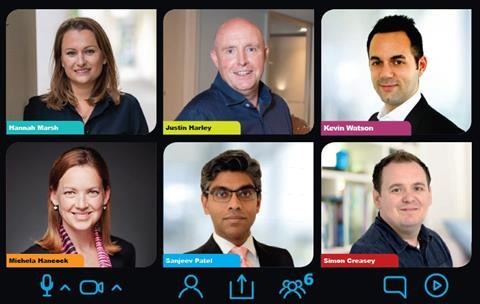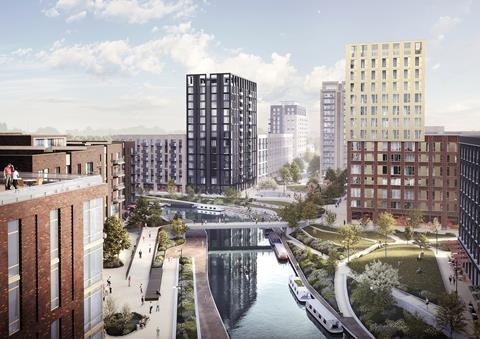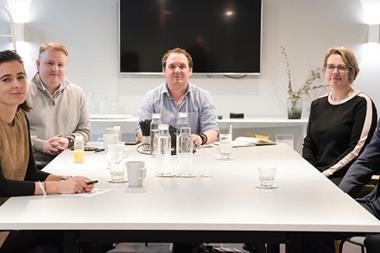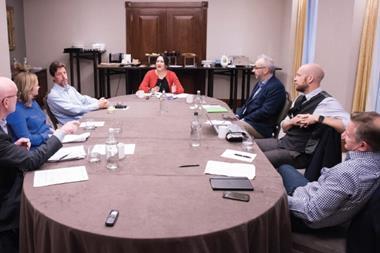Earlier this month, in the latest in the Yardi Think Tank series, Property Week contributing editor Simon Creasey chaired a discussion with key figures in the UK build-to-rent sector on how Covid-19 has affected BTR and the factors driving innovation for investors and residents. Also up for debate was how the pandemic might affect future BTR development.
Panel of experts
- Michela Hancock, managing director, Greystar Europe
- Justin Harley, regional director, Yardi Systems
- Hannah Marsh, co-founder & marketing director, HomeViews
- Sanjeev Patel, managing director, PPP Capital
- Kevin Watson, operations and commercial director, Platform_
- Simon Creasey, contributing editor, Property Week (chair)

What impact has the Covid-19 lockdown had on your operations so far?
Kevin Watson: The main impact has been on amenities spaces, which obviously have been closed now for a significant amount of time, and that’s clearly a key part of the value proposition of BTR. On the operations side, the thing that’s been really good to see is the transition to virtual and video viewings and other tools that enable engagement with residents. I think we’ve all been pleasantly surprised at how a lot of people both from the operator side and also from the resident’s side have taken to that. We still have some way to go to make those virtual viewings as interactive and as effective as a face-to-face viewing, but it’s been great to see that come through.
Michela Hancock: We’re all kind of dealing with similar situations with our residents, but one of Greystar’s big selling points is our on-site amenities and teams, and that feeling of community and engagement that our residents have with our teams. They really get to know them and it is a bit like a family. I think that it was challenging to manage that at first, because there’s no playbook for how to deal with a pandemic. The biggest shock for our residents initially was explaining that the amenity spaces were shut down, but because we had on-site teams with that existing strong relationship, they could work through that with the residents, who very quickly understood why everything was shutting down. We also introduced a strong virtual suite of options on demand, whether that be fitness, health and wellbeing, cooking challenges or book clubs. The same percentage of people that showed up to in-person events are doing the virtual events, which is pretty interesting.

Sanjeev Patel: We don’t have on-site staff – we try and do everything virtually. So we have a virtual concierge and virtual services, and it’s been a time to encourage people to start engaging with the technology and to start interacting and communicating with us. It’s all about engagement and keeping residents up to date with what we’re doing to make their place safer and telling them what changes we might be making and why.
“It’s time for the BTR sector to raise its head and make renters know that this option is available to them”
Justin Harley
Justin Harley: This is a generational event that we are going through right now and what I have seen from the sector is a real sense of community. I know there are going to be challenges, but I’ve only heard really positive things, not only about how operators work with their residents, but also how they work with their investors and with other BTR operators. I think it’s time for the BTR sector to raise its head and make renters know that this option is available to them.
What is driving the way UK BTR schemes are delivered? Are they being driven by residents’ needs or by investors looking for greater returns on investment?
MH: I think it’s hard to say if it’s one or the other because they’re so interconnected. I think investors really care about who the operator is and making sure they have experience, the platforms set up and the technology to respond to the needs of the residents, and that flexibility is built in. It’s the responsibility of the developer and operator to know their customer base and try to interpret their needs, what amenities they want and what services are important to them. We don’t have a crystal ball. Sometimes we think we know what our residents will want, but then we find out that what they want is completely different. But having a very mature platform allows us to adapt quickly. So if we realise that amenity space isn’t being used as a cinema, we can quickly change it into something else. So I think it’s just realising you always need to be flexible, listen to customer feedback and then quickly shift and change.
SP: I agree. You can’t specify whether it is the product that is driving the innovation or whether the consumer need is. When you start providing amenities tailored around your expected customer base, the customer very, very quickly adapts them and starts to use these facilities and amenities, which in turn makes them stickier. So the turnover from our rental products is very low and I’m sure it is for all of you guys in the sector, because we provide a better amenity and a better quality of environment for the resident. And because they have a better quality of environment, more technology and more amenities in house, they get used to it and in return we have less void periods and therefore higher returns.

KW: The reality in BTR is you need residents who want to stay and to pay the premium rents – that’s the way you drive your return on investment. So yes, innovation is clearly driven by residents. Sometimes we’re not really sure exactly what the residents want and we get it maybe 80% right and have to learn the rest as things change. But if they value that innovation, then they’re going to stick around longer, they’re going to pay more rent, and therefore you’re gonna get a better return. So investors are incentivised in the same way I think the residents are when it comes to innovation.
Covid-19 has caused more people to work from home than ever before. Do you think having facilities to allow people to work not just in their apartment but possibly in a coworking space, or something similar in their building, is something that you may have to design into your amenities in future?
KW: Yes, from our perspective. We’ve got a lot of that [sort of space] already built into our developments and we may dial it up a bit.
HM: That relates to flexibility. If you’ve got the opportunity to flex your offering and maybe use the communal areas for coworking in the week and then change that around at the weekend to provide space that can be used for communal events, it’s going to be those buildings that can be a bit nimble in the current situation that I think are going to bounce back more quickly.
“It’s going to be those buildings that can be a bit nimble in the current situation that are going to bounce back”
Hannah Marsh
MH: We’ve been asked a lot of questions about whether will we adapt our amenity space and have more coworking pods and things like that. The answer is we’re not exactly sure yet. I suspect we’ll probably design in more workspace in the units. We’re also seeing some people upgrading from one bedroom to two bedrooms to just have a little bit more space, which we were a little bit surprised by and I’m curious to see if that trend continues.
There’s been an amenities arms race in the BTR sector over the past few years. Will BTR investors have to accept reduced service charge income from things like amenities space as social distancing guidelines mean less people can now use them at the same time?
MH: If it’s managed properly I don’t think that will happen. This is a completely new world and I think that we will just offer more and more options for events, and maybe do more things outdoors. Because we have those on-site teams and those community managers and events managers at larger schemes like Greenford Quay, we will just adapt and shift and offer a wider range [of activities]. I don’t see it affecting returns, but I think that’s because we have the platform to adapt quickly.

KW: I think the reality is that none of us are quite sure exactly what the future holds, but people might actually spend less time outside their developments. They may be less keen to go to an external gym where they don’t know exactly what’s happening day-to-day. So I think the amenity space might be seen as actually being more valuable than it was before.
We’ve all become familiar with having conversations on Zoom and Teams. Will it become increasingly important to make sure BTR developments have infrastructure to support this type of activity?
JH: The simple answer is yes. The other bit of the business that I run at Yardi is the flexible workspace industry and there is an interesting difference between it and the BTR sector at the moment. One group of my customers, the coworking sector, has got buildings that are empty and the other group, BTR, has buildings that are full of people working from home. The coworking companies are doing surveys with their members and finding that a lot of them can’t wait to get back to the office because their home broadband is so bad. Now I suspect that in a BTR development broadband is of a much higher standard than a typical home internet connection, but the reality is that we’re going to be spending more and more of our time online, so it will require a constant upgrade process to meet that capacity.
Find out more - Power of Proptech 2020: lockdown fuels take-up of tech
HM: We don’t see broadband raised as an issue very often on HomeViews. It’s almost an expectation from a resident’s perspective: “I’m moving into a brand new building, so I’m going to have great broadbrand – it’s all going to be set up, it’s going to work”. It’s only really brought up when there’s an issue. But I do think that there are other opportunities to improve the customer experience by using technology and that relates to making your residents feel safe, secure and looked after. For instance, a lot of maintenance calls could be fixed over video. And you could use technology to manage capacity within your communal spaces. So how technology can be increased and used smartly is another big opportunity for the sector.

KW: I think the biggest change [we’ve seen during the lockdown] is video has become acceptable and the norm. On the maintenance point, if one of our maintenance guys had previously said: “We’re going to video call you to sort out a problem,” a resident would probably think “Why are you doing that?” But now they will probably think: “Yeah, that makes perfect sense.” So I think video becoming the norm is a huge step forward.































No comments yet